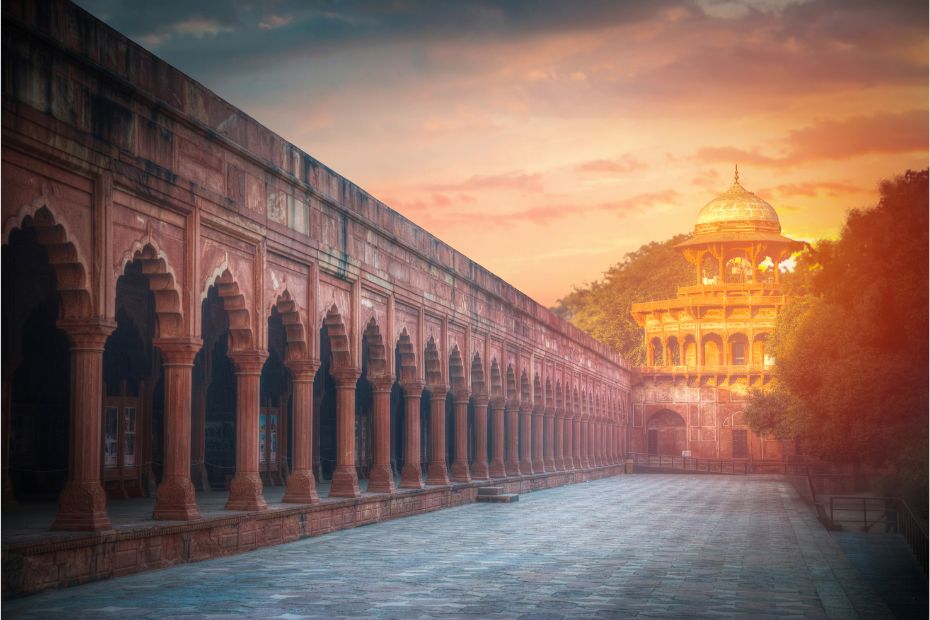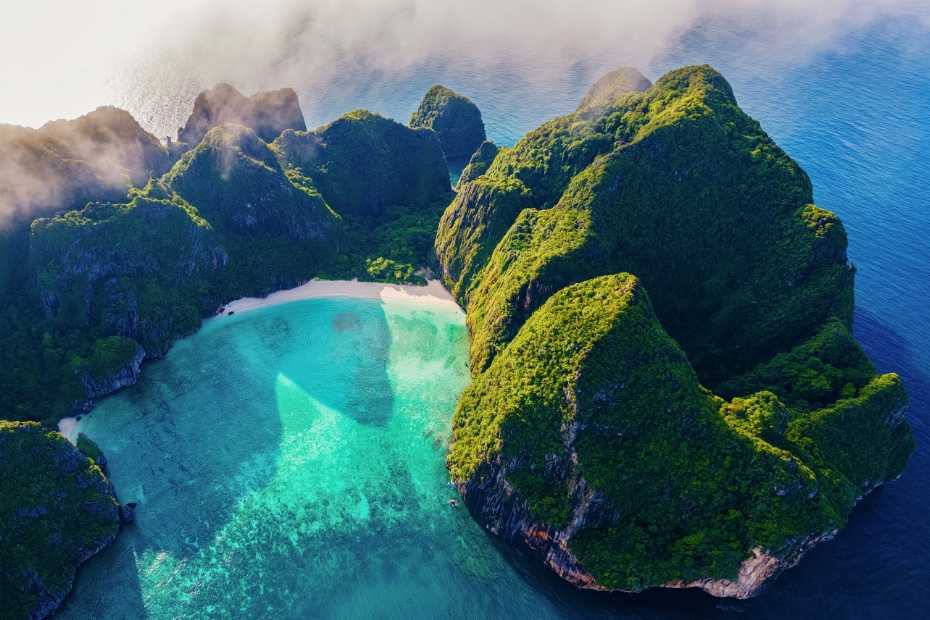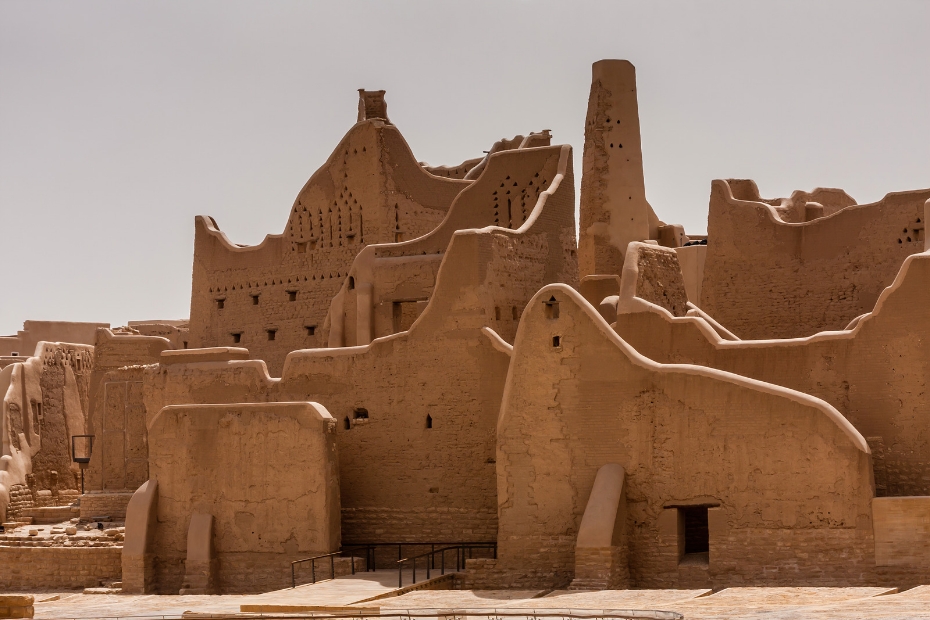Journey through the captivating Red Fort and uncover the architectural treasures and historical significance of this Delhi landmark.
Step into the Red Fort, a world of Mughal grandeur and rich Indian history. This iconic fortress boasts towering walls and ornate structures. You’ll feel transported as you explore its vast complex.
This blog will uncover the Red Fort’s architectural masterpieces, earning it UNESCO World Heritage status. We’ll reveal its captivating history, from Emperor Shah Jahan’s vision to India’s independence struggle. Plus, we’ll share essential visitor tips for an unforgettable experience.
Ready for an incredible journey? Lace up your walking shoes and grab your camera. Let’s dive into the Red Fort, Delhi’s iconic architectural brilliance and a cultural heritage symbol.
A Walk Through the Red Fort’s Historic Halls
Visiting the Red Fort is like stepping back in time as you wander through its majestic halls and palaces. Here, we provide an in-depth exploration of the historic halls within the Red Fort complex:
Diwan-i-Aam: The Hall of Public Audiences
Diwan-i-Aam is a grand, open hall where Emperor Shah Jahan addressed his subjects. This space is characterized by:
- A large, rectangular chamber adorned with red sandstone
- Beautiful arches and columns that support a flat roof
- An intricately designed throne for the emperor, positioned on a raised platform
- The presence of numerous balconies, where the courtiers and nobles stood
- A garden area surrounds the hall, adding to its aesthetic appeal
While exploring Diwan-i-Aam, make sure to:
- Observe the detailed carvings on the columns and arches
- Imagine the emperor seated on his throne, listening to the grievances of his people
- Take a stroll in the garden to appreciate the Mughal love for landscaping
Diwan-i-Khas: The Hall of Private Audiences
Diwan-i-Khas served as a private audience chamber for the emperor. It is distinguished by:
- An exquisitely decorated interior featuring white marble and intricate inlays
- A famous inscription reads, “If there is a paradise on earth, it is this, it is this, it is this”
- The legendary Peacock Throne, which was placed here before being taken by the Persians
- A central pillar with a circular platform for the emperor’s seat
- Delicately carved marble screens that offered privacy
As you tour the Diwan-i-Khas, be sure to:
- Marvel at the craftsmanship of the marble inlays and carvings
- Reflect on the opulence of the Mughal court during its heyday
- Ponder the significance of the Peacock Throne and its disappearance
Rang Mahal: The Palace of Colors
Rang Mahal was the residence of the emperor’s wives and royal women. Key features of this palace include:
- Lavish chambers adorned with colorful paintings, gold, and precious stones
- A central marble pool, known as the “House of Waters,” kept the palace cool
- A finely crafted, gilded ceiling that resembles a shimmering night sky
- An exclusive entrance for the emperor, separate from the main entrance
While visiting Rang Mahal:
- Marvel the vibrant colors and intricate details of the interior design
- Appreciate the innovative cooling system of the central marble pool
- Consider the private lives of the royal women who once resided here
Khas Mahal: The Private Palace
Khas Mahal functioned as the emperor’s private residence. Elements of this palace include:
- Exquisite white marble architecture with gold and blue inlays
- Three sections: a sleeping chamber, a sitting room, and a wardrobe area
- Delicate marble screens offer privacy while allowing natural light to filter through
- Panoramic views of the Yamuna River from the palace’s eastern side
During your time at Khas Mahal:
- Esteem the splendid combination of marble, gold, and blue inlays
- Imagine the emperor’s daily life within these private quarters
- Enjoy the views of the Yamuna River from the palace’s vantage point
Moti Masjid: The Pearl Mosque
Moti Masjid is a small, private mosque built for the emperor’s personal use. Distinctive features of this serene structure include:
- Elegant white marble construction that gives it a pearl-like appearance
- Three domes adorn the roof, adding to its architectural beauty
- A prayer hall with a façade of seven arched openings, creating a sense of harmony
- A courtyard with a small ablution pool for ritual cleansing before prayers
- Minimalistic design, emphasizing the spiritual purpose of the mosque
While visiting Moti Masjid, make sure to:
- Appreciate the simplicity and elegance of the white marble structure
- Contemplate the spiritual life of the emperor and his devotion to prayer
- Take a moment to soak in the serene atmosphere within the mosque’s confines
In summary, a visit to the Red Fort offers a fascinating journey through its historic halls, each with its unique character and purpose. From the grandeur of Diwan-i-Aam to the luxury of Diwan-i-Khas, the vibrant Rang Mahal to the intimate Khas Mahal, and the serene Moti Masjid, you’ll be immersed in the Mughal world of art, architecture, and royal life. As you explore these extraordinary spaces, take the time to appreciate the intricate craftsmanship, rich history, and stories unfolding within their walls. This once-in-a-lifetime experience will leave you with a profound understanding of India’s past and the legacy of the Mughal Empire.
The Architecture and Design of the Red Fort
Explore the fascinating architecture and design of the Red Fort, a stunning testament to Mughal artistry and engineering. The fort’s intricate design, key structures, and materials used in its construction are all essential aspects of this architectural marvel.
Mughal Architecture and Influences: The Red Fort exemplifies Mughal architecture, characterized by:
- Grand scale: The fort’s immense size reflects the grandeur of the Mughal Empire.
- Symmetry: A balanced, harmonious design is evident throughout the complex.
- Ornate decoration: Detailed carvings, inlays, and calligraphy adorn various structures.
- Gardens: Mughals were known for their love of gardens, which you can witness at the fort.
- Domes and arches: These iconic features are prominent in the Red Fort’s design.
Major Structures within the Complex: The Red Fort is home to several significant structures, including:
- Lahori Gate: The main entrance has intricate carvings and an impressive façade.
- Delhi Gate: Another entrance showcasing beautiful geometric patterns and floral motifs.
- Chhatta Chowk: A bustling marketplace where traders once sold luxurious goods.
- Naubat Khana: A ceremonial music pavilion where musicians played for the emperor.
- Diwan-i-Aam: The emperor’s public audience hall, with an impressive throne alcove.
- Diwan-i-Khas: A private audience chamber featuring a dazzling interior and the legendary Peacock Throne.
- Rang Mahal: A royal women’s palace decorated with colorful paintings and a central marble pool.
- Khas Mahal: The emperor’s private quarters, characterized by lavish white marble and inlays.
- Moti Masjid: A serene, white marble mosque for the emperor’s personal use.
Materials Used and Conservation Efforts: The Red Fort is primarily constructed from red sandstone, which gives the fort its distinctive color. Other materials used include:
- White marble: Featured in several structures, such as the Diwan-i-Khas and Moti Masjid.
- Semi-precious stones: Used for intricate inlay work and to embellish various interiors.
- Gold and silver: Employed decorative elements to heighten the fort’s opulence.
Preserving the Red Fort’s architectural integrity is a priority for conservationists. Efforts include:
- Structural repairs: Addressing wear and tear, such as cracks and damaged carvings.
- Restoration: Reviving the original splendor of the fort’s art, inlays, and paintings.
- Environmental protection: Implementing measures to shield the fort from pollution and weathering.
In conclusion, the Red Fort’s architecture vividly represents Mughal artistry and engineering prowess. Its harmonious design, impressive structures, and the materials used in its construction showcase the empire’s grandeur. Furthermore, ongoing conservation efforts ensure that the fort remains a testament to India’s rich cultural heritage for future generations to admire.
Red Fort Sound and Light Show
Unveil the enchanting world of the Red Fort through its mesmerizing Sound and Light Show. This immersive experience brings the fort’s history to life in vivid detail, captivating your senses with a blend of technological marvels and vivid storytelling.
The show’s specifics: During the Sound and Light Show, you’ll witness various key events and periods of Indian history. The performance features:
- A dramatic recreation of Mughal battles and court life
- The rise and fall of Mughal emperors, including Shah Jahan and Aurangzeb
- The British occupation and the subsequent fight for Indian independence
- The story of how the Red Fort became an enduring symbol of India’s rich heritage
Timings and tickets: To catch the show, note that there are two performances each evening. The English version typically starts at 7:30 PM during summer and 6:30 PM in winter. The Hindi version follows, commencing around 9:00 PM in summer and 8:00 PM in winter. However, these timings may change, so it’s best to confirm the schedule beforehand.
As for the tickets, you can purchase them at the Red Fort’s ticket counter or via online platforms. The prices vary, with Indian nationals paying INR 60 and foreign visitors charged INR 200. Child rates are also available. Seating operates on a first-come, first-served basis, so arrive early to secure prime seating.
Gaining a deeper understanding: Attending the Red Fort Sound and Light Show will give you a more profound appreciation for India’s rich and diverse history. The show’s powerful visual and audio components transport you back to the Mughal era, allowing you to envision the lives of the emperors and the events that shaped the fort’s legacy.
Furthermore, the performance emphasizes the fort’s significance as an iconic symbol of India’s cultural and historical identity. As the colorful lights illuminate the towering sandstone walls and the sounds of battle echo through the complex, you’ll be captivated by the stories unfolding before you.
How to Visit the Red Fort
Are you planning a visit to the Red Fort? Here’s all you need to know about location, accessibility, entry fees, timings, the best time to visit, and nearby attractions and eateries.
Location and Accessibility: The Red Fort is located in Old Delhi, near the banks of the Yamuna River. To reach the fort:
- Metro: Use the Delhi Metro’s Violet Line and disembark at Lal Qila station.
- Auto-rickshaw: Hire an auto-rickshaw from anywhere in Delhi.
- Taxi: Book a cab or use a ride-sharing app.
Entry Fees and Timings: The Red Fort is open to visitors from Tuesday to Sunday, 7:00 AM to 5:30 PM. The fort is closed on Mondays. Entry fees are:
- Indian nationals: INR 35 per person
- Foreign citizens: INR 550 per person
- Children below 15 years: Free entry
Best Time to Visit: The ideal time to visit the Red Fort is during the cooler months, from October to March. During this period:
- Weather: Pleasant temperatures make exploring the expansive fort more comfortable.
- Festivals: Experience the cultural extravaganza of events like Diwali and Republic Day.
Nearby Attractions: After visiting the Red Fort, consider exploring nearby attractions, such as:
- Jama Masjid: India’s largest mosque with impressive architecture and a panoramic city view.
- Chandni Chowk: A bustling market that offers a sensory feast and an authentic taste of Old Delhi.
- Humayun’s Tomb: A UNESCO World Heritage Site and a remarkable example of Mughal architecture.
- Raj Ghat: A memorial dedicated to Mahatma Gandhi, marking the spot of his cremation.
Places to Eat: Savor the local flavors at nearby eateries, including:
- Karim’s: A historic restaurant serving mouthwatering Mughlai cuisine.
- Paranthe Wali Gali: A famous street offering a variety of stuffed parathas.
- Kuremal Mohan Lal Kulfi Wale: A renowned dessert shop for traditional Indian ice cream (kulfi).
- Aloo Tikki Wala: A popular street food joint for delicious aloo tikki and chaat.
Frequently asked questions about Red Fort
What is the history of the Red Fort?
The Red Fort, also known as Lal Qila, was the main residence of Mughal emperors from 1648 until 1857. Built during the reign of Emperor Shah Jahan, the fort witnessed various historical events and changes in power. Post-independence, it became a symbol of India’s heritage and freedom struggle.
Who built the Red Fort, and when was it built?
Emperor Shah Jahan commissioned the construction of the Red Fort in 1638. The fort was completed in 1648, becoming the center of Mughal power and an architectural marvel of its time.
What is the significance of the Red Fort in Indian history?
The Red Fort is significant in Indian history as the primary residence of Mughal emperors and a symbol of their grandeur. After India’s independence, the fort became a symbol of the nation’s freedom struggle and is the site of the Prime Minister’s annual Independence Day address.
What are the main structures within the Red Fort complex?
Major structures within the Red Fort complex include Lahori Gate, Delhi Gate, Chhatta Chowk, Naubat Khana, Diwan-i-Aam, Diwan-i-Khas, Rang Mahal, Khas Mahal, and Moti Masjid.
What is the architectural style of the Red Fort?
The Red Fort showcases Mughal architecture, characterized by grand scale, symmetry, ornate decoration, gardens, and iconic features such as domes and arches.
What materials were used in the construction of the Red Fort?
Red sandstone is the primary material used to construct the Red Fort. White marble, semi-precious stones, gold, and silver were used for various structures and decorative elements.
What are the visiting hours and entry fees for the Red Fort?
The Red Fort is open from Tuesday to Sunday, 7:00 AM to 5:30 PM. Entry fees are INR 35 for Indian nationals, INR 550 for foreign nationals, and free for children below 15 years.
What is the best time of year to visit the Red Fort?
The ideal time to visit the Red Fort is during the cooler months, from October to March, when temperatures are pleasant and various cultural events and festivals occur.
Are there any special events or shows at the Red Fort?
The Red Fort hosts a captivating Sound and Light Show in the evenings, which uses powerful sound effects and colorful lights to narrate the fort’s history and the stories of its emperors.
What are some nearby attractions and places to eat near the Red Fort?
Nearby attractions include Jama Masjid, Chandni Chowk, Humayun’s Tomb, and Raj Ghat. Karim’s, Paranthe Wali Gali, Kuremal Mohan Lal Kulfi Wale, and Aloo Tikki Wala are popular eateries.
How can I reach the Red Fort using public transportation?
The Red Fort is accessible via Delhi Metro’s Violet Line (Lal Qila station), auto-rickshaw, or taxi.
Are there guided tours available at the Red Fort?
Yes, guided tours are available at the Red Fort, providing visitors with in-depth information about the fort’s history, architecture, and significance.



